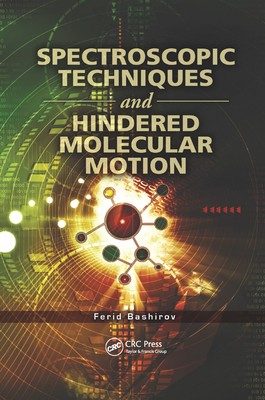
- We will send in 10–14 business days.
- Author: Ferid Bashirov
- Publisher: CRC Press
- ISBN-10: 0367382288
- ISBN-13: 9780367382285
- Format: 15.2 x 23.1 x 1 cm, softcover
- Language: English
- SAVE -10% with code: EXTRA
Spectroscopic Techniques and Hindered Molecular Motion (e-book) (used book) | bookbook.eu
Reviews
Description
Spectroscopic Techniques and Hindered Molecular Motion presents a united, theoretical approach to studying classical local thermal motion of small molecules and molecular fragments in crystals by spectroscopic techniques. Mono- and polycrystalline case studies demonstrate performance validity.
The book focuses on small molecules and molecular fragments, such as N2, HCl, CO2, CH4, H2O, NH4, BeF4, NH3, CH2, CH3, C6H6, SF6, and other symmetrical atomic formations, which exhibit local hindered motion in molecular condensed media: molecular and ionic crystals, molecular liquids, liquid crystals, polymeric solids, and biological objects. It reviews the state of studying the hindered molecular motion (HMM) phenomenon and the experimental works on the basis of the latest theoretical research.
Case Studies
- Physical models of hindered molecular motion
- General solution of the stochastic problem for the hindered molecular motion in crystals
- Formulae of the angular autocorrelation function symmetrized on the crystallographic point symmetry groups
- Formulae of the spectral line shapes concerning the dielectric, infrared, Raman, nuclear magnetic relaxation, and neutron scattering spectroscopy in the presence of the hindered molecular motion
- Experimental probation of the theoretical outcomes
- Proton relaxation in three-atomic molecular fragments undergoing axial symmetry hindered motion
- Structural distortion in the ordered phase of crystalline ammonium chloride
Organic compounds, polymers, pharmaceutical products, and biological systems consist of the molecular fragments, which possess rotational or conformational degrees of freedom or an atomic exchange within the fragme
EXTRA 10 % discount with code: EXTRA
The promotion ends in 16d.12:54:31
The discount code is valid when purchasing from 10 €. Discounts do not stack.
- Author: Ferid Bashirov
- Publisher: CRC Press
- ISBN-10: 0367382288
- ISBN-13: 9780367382285
- Format: 15.2 x 23.1 x 1 cm, softcover
- Language: English English
Spectroscopic Techniques and Hindered Molecular Motion presents a united, theoretical approach to studying classical local thermal motion of small molecules and molecular fragments in crystals by spectroscopic techniques. Mono- and polycrystalline case studies demonstrate performance validity.
The book focuses on small molecules and molecular fragments, such as N2, HCl, CO2, CH4, H2O, NH4, BeF4, NH3, CH2, CH3, C6H6, SF6, and other symmetrical atomic formations, which exhibit local hindered motion in molecular condensed media: molecular and ionic crystals, molecular liquids, liquid crystals, polymeric solids, and biological objects. It reviews the state of studying the hindered molecular motion (HMM) phenomenon and the experimental works on the basis of the latest theoretical research.
Case Studies
- Physical models of hindered molecular motion
- General solution of the stochastic problem for the hindered molecular motion in crystals
- Formulae of the angular autocorrelation function symmetrized on the crystallographic point symmetry groups
- Formulae of the spectral line shapes concerning the dielectric, infrared, Raman, nuclear magnetic relaxation, and neutron scattering spectroscopy in the presence of the hindered molecular motion
- Experimental probation of the theoretical outcomes
- Proton relaxation in three-atomic molecular fragments undergoing axial symmetry hindered motion
- Structural distortion in the ordered phase of crystalline ammonium chloride
Organic compounds, polymers, pharmaceutical products, and biological systems consist of the molecular fragments, which possess rotational or conformational degrees of freedom or an atomic exchange within the fragme


Reviews